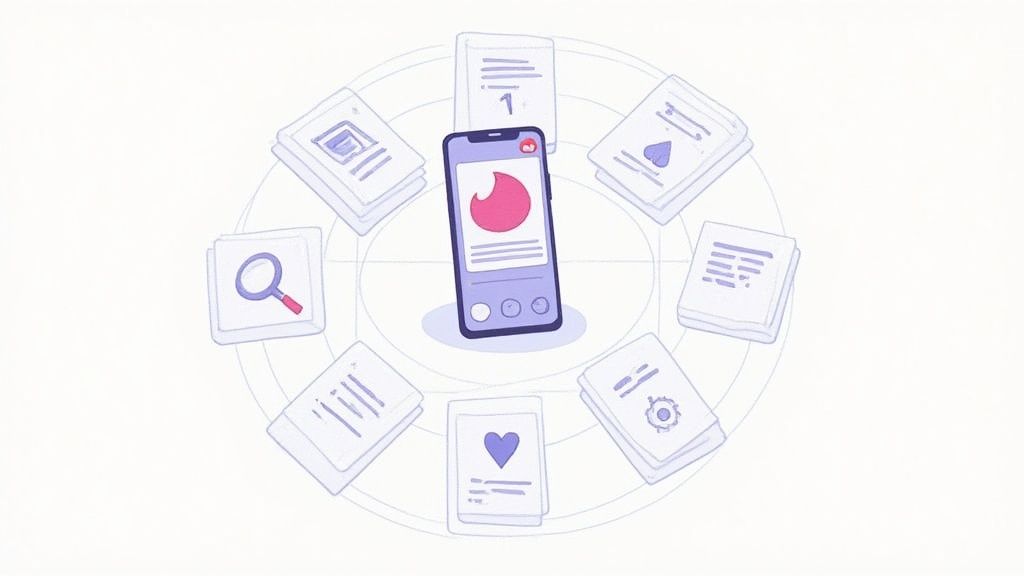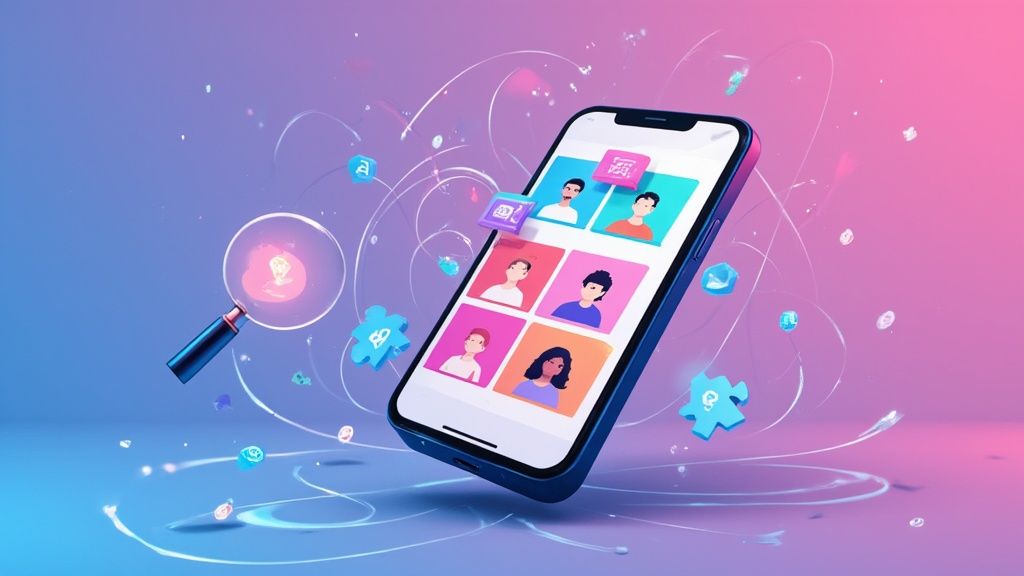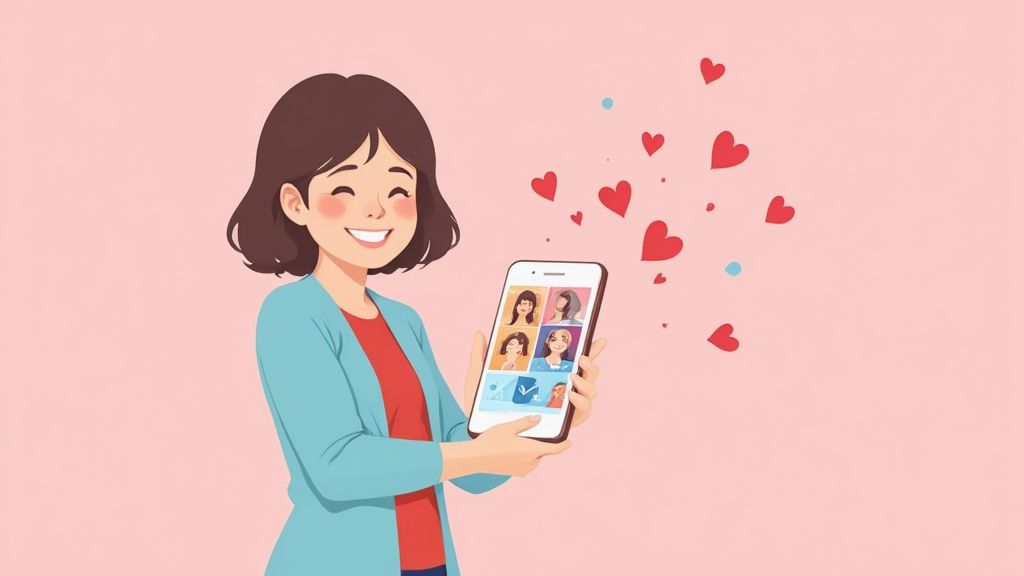Your Guide to Online Dating Bots
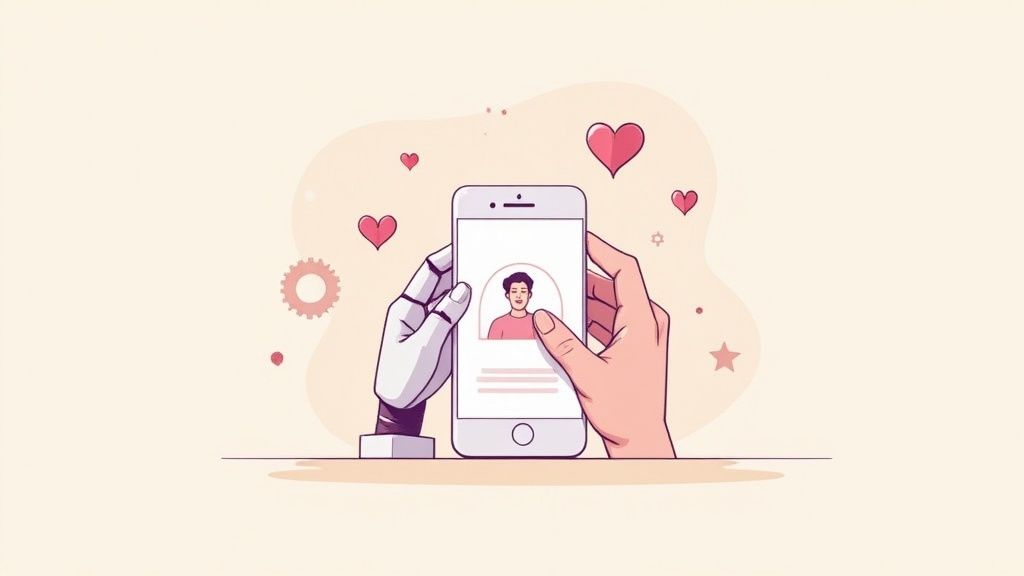
Let's be honest, swiping through endless dating profiles is a grind. That's where online dating bots come in. Think of them as a personal assistant for your dating life, stepping in to handle the most repetitive tasks so you can focus on what actually matters—making genuine connections.
What Are Online Dating Bots Anyway?
At its core, an online dating bot is just a piece of software built to automate actions on a dating app for you. Its main job is to take the most time-consuming parts of the process, like swiping, off your plate.
It’s a bit like setting up filters in your email. You can create a simple rule that automatically sends all promotional emails to a specific folder. A basic auto-swiper does something similar: it follows a simple rule you set—like an age range or distance—and sorts profiles by swiping right or left for you.
Now, imagine a smarter assistant that could draft replies to your emails. That's a lot closer to what the more advanced AI-powered dating bots can do. These tools don't just swipe; they can start conversations, learn from how you chat, and adapt their style to sound more like you.
This infographic breaks down the difference perfectly.
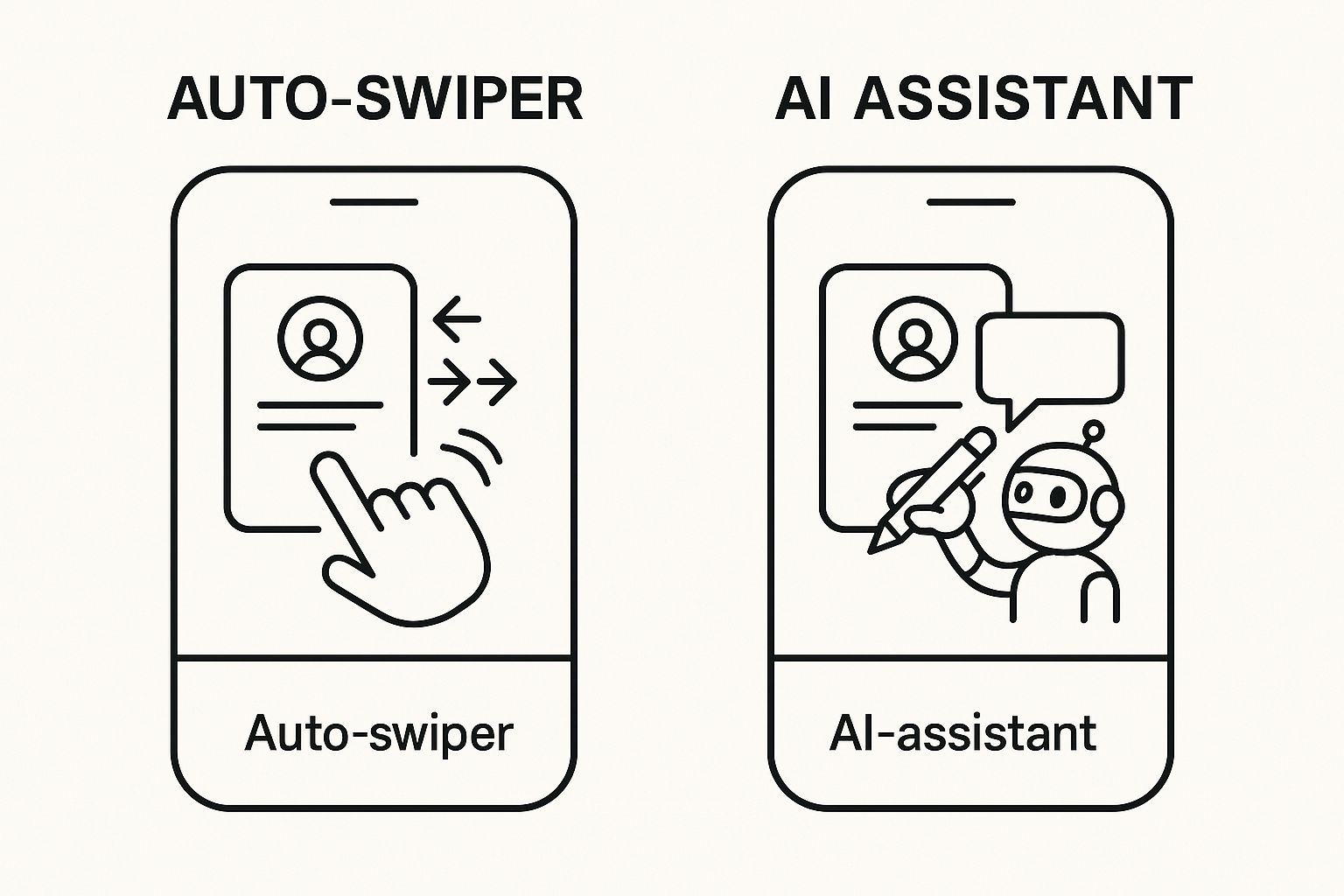
The key takeaway here is pretty clear: simple bots are all about volume (getting more swipes in), while advanced AI aims for quality interaction (actually starting conversations). Understanding this distinction is crucial to using these tools the right way.
The Spectrum of Dating Automation
Not all dating bots are the same. They range from super simple scripts to seriously complex AI. Knowing the difference helps you figure out what they're actually capable of.
Here’s a quick look at the main types of dating automation tools, from the most basic to the most sophisticated.
Comparing Different Types of Dating Bots
| Bot Type | Main Purpose | How It Works | Common Example |
|---|---|---|---|
| Simple Auto-Swiper | Maximizing matches | Swipes right on every profile within basic filters (age, distance). | A basic script or a simple browser extension. |
| Intelligent Swiper | Finding better matches | Analyzes profile text for keywords you like (or dislike) before swiping. | Auto-Swiper's keyword filtering feature. |
| AI Chatbot | Starting conversations | Uses natural language processing (NLP) to send openers and initial replies. | An AI-driven tool that integrates with a messaging API. |
As you can see, the technology can either cast a wide net or use a very precise spear, depending on what you're trying to accomplish.
The whole point of a dating bot is efficiency. The average person spends hours every single week just swiping and sending openers. These tools are designed to give you that time back, letting you step in only when a real, promising conversation has started.
How Do They Actually Work?
So, how does a piece of software manage to "swipe right"? Most online dating bots are browser extensions or desktop apps that work with the web version of a dating app like Tinder or Bumble.
They essentially mimic what a human does. The bot's code identifies the key elements on the screen—the "like" button, the "pass" button, and the user profiles themselves—and then programmatically triggers clicks. It loads a profile, checks it against your preset filters, and tells the browser to click the right button. It repeats this process over and over, sometimes thousands of times.
The more advanced AI bots take it a step further by connecting to large language models to generate text for messages, which can make their conversations feel surprisingly human. This is how you can be racking up matches and starting chats while you're busy at work, asleep, or just away from your computer.
Why Are Dating Bots Suddenly Everywhere?
Let's be honest, the modern dating scene can feel less like a romance novel and more like a full-time job. With millions of people packed into a handful of apps, just trying to find a decent connection is exhausting. This is precisely why online dating bots have gone from a niche tech curiosity to a go-to tool for so many people.
Think of it this way: you're trying to find one specific book in a massive library with no card catalog. You could wander the aisles for weeks, or you could use a scanner to do the heavy lifting for you. Dating bots are that scanner, built to sift through the noise and handle the overwhelming scale of today's dating world.
The endless cycle of swiping, trying to come up with a clever opener, and juggling a dozen dead-end chats leads to a very real problem: "swipe fatigue." People are simply getting burned out by the repetitive, low-reward grind, making them want to delete the apps altogether.
It’s a Problem of Scale and Saturation
Online dating isn't a small pond anymore; it’s a massive, global ocean of profiles. The sheer number of people all competing for attention makes it incredibly hard to stand out from the crowd.
This explosion in users has created the perfect environment for automation. The global user base for dating apps is on track to blow past 500 million by 2025, with the market expected to rake in a cool $9.2 billion. And get this: within that massive pool, 26% of users have already admitted to flirting with AI chatbots, whether they knew it or not. It just shows how common automated interactions have become.
All this saturation means that for every profile you swipe on, hundreds—or even thousands—of other people are seeing it too. You simply can't keep up manually. That’s where automation comes in to level the playing field.
"The core issue is time. People want the results of online dating—meaningful connections—but lack the hours required for the repetitive swiping and initial messaging. Bots are a direct response to this efficiency gap."
A Solution Born from How We Actually Use Apps
The hunt for a more efficient way of doing things isn't just a dating app problem. It's a trend we see all over the internet. Automation is already a huge part of the digital world, with countless people and businesses using social media automation tools to manage posts and messages. It’s all about saving time.
Online dating bots work on the exact same principle. They solve the real-world frustrations that pop up when you're trying to date online:
- Getting More Eyes on Your Profile: A bot can fire off thousands of swipes in the time it takes you to get through a few dozen. This massively increases your potential match count.
- Cutting Through the Clutter: Instead of manually reading every single bio, a bot can pre-filter profiles for you based on keywords or other criteria you set.
- Beating Burnout: Let's face it, getting ghosted or having conversations fizzle out is discouraging. A bot can handle those early, often disappointing, stages for you.
At the end of the day, the rise of dating bots isn't about faking a connection. It's a practical solution for a saturated and genuinely tiring environment. These tools are popular because they give you a strategic edge, letting you save your energy for the conversations that actually matter instead of getting lost in an endless sea of profiles.
Spotting and Avoiding Malicious Scam Bots
Not all online dating bots are on your team. While some are designed to save you time by automating swipes, others are built with a much darker purpose in mind. These malicious bots are the shady operators behind sophisticated romance scams, created to play on your emotions and empty your wallet.
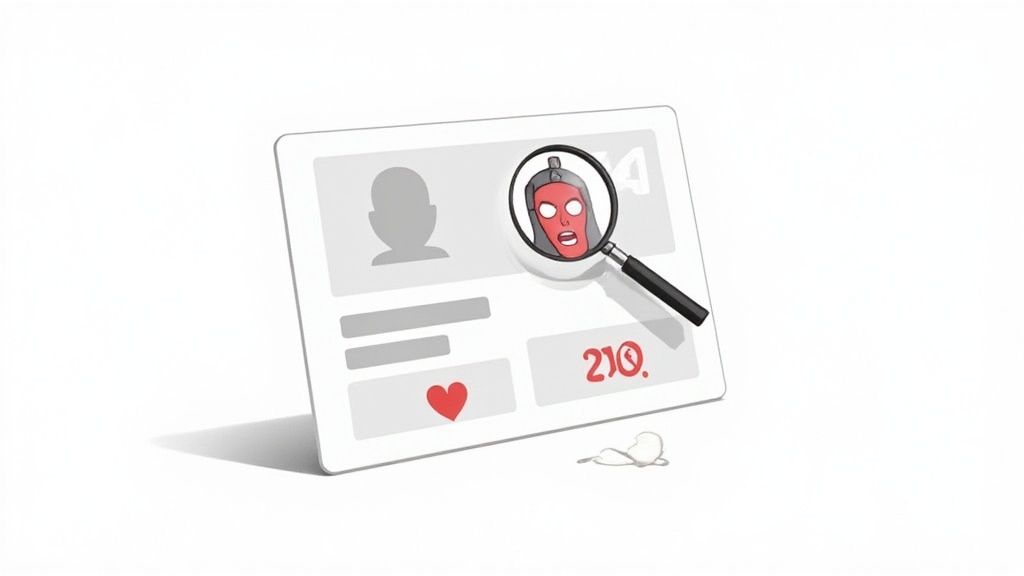
Unlike a straightforward auto-swiper, scam bots are often powered by advanced AI. They're capable of holding surprisingly believable, emotionally charged conversations for weeks, even months. The entire game is to build a deep, seemingly genuine connection before they ever make their move.
The damage these scams cause is staggering, both financially and emotionally. Thanks to AI-powered chatbots, romance scams have become brutally effective, with victims in the US, UK, and around the world losing an average of $8,000 each. Scammers use these bots to craft personalized messages that build trust over time. And it's a huge problem—over half of all online daters say they run into suspicious profiles every single week.
Common Red Flags of a Scam Bot
Fortunately, even the most sophisticated bots have tells. They run on scripts and predictable patterns. If you know what you’re looking for, you can spot the con before it's too late. Staying sharp is your best line of defense.
Keep an eye out for these classic warning signs:
- The Profile is Too Perfect: Scammers love using stolen photos of models or actors. If their pictures look like they were pulled from a magazine and their bio is a little too flawless, it's time to be skeptical.
- They Want to Leave the App Immediately: It’s a classic move. They’ll push to move the chat over to WhatsApp, Telegram, or email right away. Why? Because the dating app can't monitor their activity there.
- Their Story Has Inconsistencies: A bot might forget something you told them yesterday or repeat the same story twice. Pay attention if their background seems fuzzy or the details keep shifting.
- They Avoid Video Calls: This is the biggest red flag of them all. A scammer will have an endless list of excuses—a "broken camera," "terrible internet," you name it—to avoid showing their face.
Actionable Steps to Protect Yourself
Spotting the red flags is step one, but taking proactive steps is what really keeps you safe. A few simple checks can expose a scammer in minutes, saving you from a world of potential heartbreak and financial trouble.
"The goal of a scam bot isn't just to trick you; it's to create an emotional dependency. They play the long game, making you feel understood and cared for. This emotional manipulation is what makes the final request for money so effective."
Here are a few practical things you can do the moment you feel suspicious:
- Perform a Reverse Image Search: Take their profile pictures and pop them into a tool like Google Images. If the photos show up on stock image sites, random social media profiles with different names, or known scam report forums, you've caught a bot.
- Ask Specific, Local Questions: Try to pull them off-script. Ask about a popular local restaurant or a recent community event. A bot will either give a ridiculously generic answer or get the details completely wrong.
- Watch for Repetitive Language: AI chatbots are trained on scripts and tend to recycle their material. If you notice they’re using the same exact compliments, phrases, or questions over and over, you’re almost certainly not talking to a real person.
- Trust Your Gut: Seriously. If something just feels off, it probably is. Never ignore that feeling. Intense pressure to send money, wild, overly dramatic life stories, and slippery, evasive answers are all massive warning signs. For a deeper dive, check out our guide on online dating safety tips.
The Growing World of AI Companionship
Beyond just automating swipes on dating apps, there’s a whole different universe opening up: AI companionship. This isn't about finding a human partner anymore. The goal here is to build an ongoing, simulated relationship with an AI.
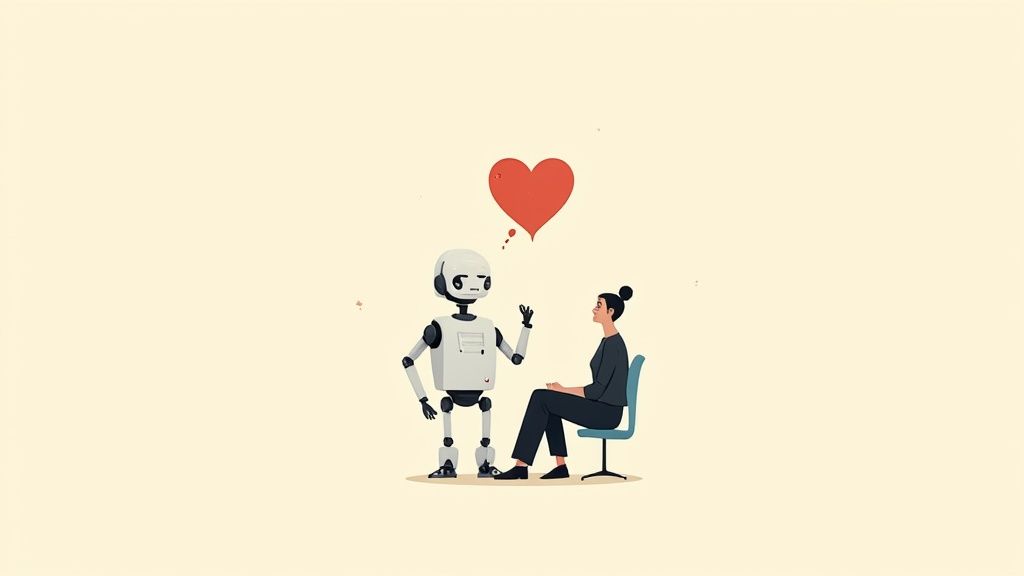
These AI personalities are a world away from a simple auto-swiper. They’re built to remember past conversations, develop their own unique ways of talking, and offer consistent emotional support. It sounds like science fiction, but it's a very real—and booming—market.
The tech behind these companions relies on sophisticated large language models. This allows them to hold conversations that feel meaningful, personal, and adaptive. They can ask about your day, bring up your hobbies, and even evolve their "personality" based on how you interact with them.
Why Is Virtual Companionship Exploding?
The sudden rise of AI companions points to a fundamental human need for connection, especially in a world that often feels isolating. For a lot of people, these bots are a judgment-free zone where they can share their thoughts and feelings, offering a kind of stability that might be missing in their real lives.
This trend is especially popular with younger, digitally-native generations who are already comfortable forming relationships through a screen. They don’t necessarily see an AI companion as a replacement for human friends, but as another layer of support.
The numbers back this up. The global market for virtual companionship and AI girlfriends is seeing insane growth. Google searches for "AI Girlfriend" shot up by a staggering 2,400%. The market itself, currently valued around $2.8 billion, is on track to hit $9.5 billion by 2028. A massive driver is Gen Z, with people under 30 making up about 80% of users. And they're not just trying it out—55% of users chat with their AI companions every single day.
More Than Just a Chatbot
What makes a true AI companion feel so different from a basic chatbot is its ability to remember and personalize. This is what creates that powerful illusion of a real, growing relationship.
Here’s how they create that sense of connection:
- Continuous Memory: They'll remember details from past chats—like your dog's name or a big project you had at work—and bring them up later.
- Emotional Responsiveness: They’re programmed to pick up on the sentiment in your messages and reply with supportive or empathetic language.
- Customizable Personalities: You can often tweak your companion's traits, from their sense of humor to their core values, essentially creating your ideal partner.
This technology is engineered to do more than just imitate a conversation; it's built to provide consistent emotional validation. For someone feeling lonely, an AI that's always there, always supportive, and always focused on them can be incredibly appealing.
As AI continues to weave itself into our lives, it’s changing more than just how we socialize. Take AI in fashion, for instance, where it’s completely changing how people manage their wardrobes and personal style. This parallel growth shows just how deeply AI is becoming a part of our daily routines.
Ultimately, the world of AI companionship brings up some big questions about relationships and what human connection really means. It's a powerful tool for fighting loneliness, but it also forces us to rethink our definitions of love and companionship. It’s a space that’s still evolving, but one thing is clear: virtual relationships are here to stay.
Using Automation Tools Responsibly
So, you’re thinking about using online dating bots to make your dating life a bit more efficient. Great! The trick is to use them smartly. Don't think of an auto-swiper as a replacement for you, but more like a super-specific personal assistant. The goal isn’t to just blast “yes” to every profile out there. It's about automating the boring, initial sorting so you only spend your precious time on profiles that actually fit what you're looking for.
This whole thing is about using tech to create more chances for a real, human connection—not faking one. When you set up automation the right way, your tool acts on your behalf, perfectly understanding your tastes and saving you from the endless, tedious swiping.
Setting Up Your Smart Filter
The real power of a tool like Auto-Swiper is in how you configure it. Instead of just letting it run wild, you need to take a few minutes to set up filters that truly reflect what you want in a partner. This is how you turn the bot from a sledgehammer into a scalpel.
Here’s how you can dial in your settings for much better results:
- Go Beyond the Basics: Don't just stop at an age range and distance. Dig deeper into what really matters to you in a match.
- Use Bio Keywords: Add words related to your hobbies, like "hiking," "live music," or "board games." This tells the tool to find people who actually share your interests.
- Filter Out Dealbreakers: Just as important, use negative keywords to automatically swipe left on profiles that mention things you're not into, like "smoker" or "just looking for fun."
This screenshot gives you a peek at how you can set up these detailed filters right inside the Auto-Swiper interface.
By putting these rules in place, you’re essentially telling the bot exactly what to look for, freeing up your time and mental energy for the good part: having great conversations.
Knowing When the Bot's Job Is Done
This is probably the most important part of using online dating bots the right way: knowing their limits. An automation tool's job is over the second a match happens. After that, it’s all you.
The whole point of automation is to open doors, not to walk through them for you. Once you have a match, the tech steps back, and real human-to-human interaction has to take over. That's where connections are actually made.
Trying to automate your conversations is a recipe for disaster. It almost always comes off as fake and completely defeats the purpose of being on a dating app. People want authenticity, and no bot can ever replicate your personality, your humor, or your empathy.
Best Practices for Responsible Automation
To get the most out of an auto-swiper without being creepy or shooting yourself in the foot, just stick to a few simple rules. This way, you’re using the tool as it was intended—to make your dating life better, not to check out of it. For a deeper dive into how these tools work, check out our complete guide on the Tinder auto liker and its features.
Here are the key best practices to live by:
- Be a Picky Filterer: The more specific you are with your keywords and filters, the better the quality of your matches will be. Simple as that.
- Take Over Immediately: The moment you get that match notification, it’s your time to shine. Jump in and start the conversation before a good connection goes cold.
- Craft a Real Opener: Your first message should always be personal. Mention something you noticed in their profile to show you actually paid attention and are genuinely interested.
- Review and Tweak: Every so often, take a look at the quality of your matches. If you're not seeing the results you want, pop back into your settings and adjust your filters.
At the end of the day, using automation responsibly is a balancing act. Let the bot handle the repetitive, high-volume swiping, but always, always save the personal and meaningful parts of dating for yourself.
Understanding the Ethics of Dating Automation
Using an online dating bot isn't just a technical move—it’s an ethical one. It opens up some big questions about being real and upfront when you're trying to connect with someone. But before we get into the deep stuff, let's talk rules. Pretty much every major dating platform has a clear policy in their terms of service: automated scripts are a no-go.
And they don't mess around with enforcement. These platforms pour a lot of resources into tech that sniffs out and flags bot-like behavior. If you get caught, you could be looking at anything from a slap on the wrist (a temporary suspension) to getting kicked off the platform for good, losing all your matches and chats in the process.
The Debate: Is It a Tool or a Deception?
Once you step outside the black-and-white of the terms of service, things get a little hazy. Is an auto-swiper just a smart way to be more efficient, or is it starting a potential relationship with a lie? Honestly, the answer really depends on how you use it and what your personal ethical compass says.
On one side, you have people who see simple auto-swipers as just a fancy filter. They argue it’s a tool to cut through the noise, saving them from swiping endlessly through profiles that don't fit what they're looking for. From this angle, the bot isn't pretending to be you; it's just doing the boring, repetitive sorting work.
The other side sees any kind of automation as a bit dishonest. The thinking is, when someone "likes" your profile, you assume they actually looked at it and made a choice. Finding out that first flicker of interest came from a bot can make the whole match feel cheap or fake, chipping away at trust before a single word is exchanged.
"The core ethical question isn't about the technology itself, but about the user's intent. Are you using a bot to create more opportunities for a genuine connection, or are you using it to replace the need for genuine effort?"
Where Do We Draw the Line?
Things get really tricky when AI chatbots get involved. A simple auto-swiper just automates an action (swiping), but an AI chatbot automates communication by pretending to be you. This is where most people agree a serious line has been crossed. A relationship, no matter how new, needs a foundation of real, authentic interaction.
Here's a simple way to think about it:
- Automation of Action: This is using a tool to do a repetitive task, like swiping based on filters you set yourself. A lot of people feel this is ethically okay.
- Automation of Interaction: This involves a tool creating messages and having conversations for you. This is almost universally seen as deceptive and unethical.
Dating platforms are always watching how users behave to keep things fair. They use pretty advanced methods to figure out how people are using their service, which you can learn more about by reading up on what user behavior analytics is all about.
At the end of the day, using an online dating bot comes down to a personal decision. You have to weigh the time you save against the risks and what your actions might say to a potential partner. It's all about finding a balance that feels both effective and, most importantly, honest to you.
Got Questions About Dating Bots?
As you start looking into the world of online dating bots, you're going to have questions. It's a space filled with a lot of noise and bad information, so let's cut through all that and get right to what you actually need to know.
Think of this as your no-nonsense guide to making a smart call on whether—and how—you want to bring a little automation into your dating life.
Can Dating Apps Actually Detect Bots?
Yes, and they’re definitely trying. Platforms like Tinder and Bumble pour a lot of money into systems built to spot behavior that doesn't look human. They're watching for patterns—things like how fast you swipe, when you log in, and if your messages seem canned. An account that swipes right on thousands of profiles in an hour? That’s a giant red flag for them.
But it’s a constant cat-and-mouse game. Smarter tools are designed to fly under the radar by randomizing their actions and staying within believable limits, making them look a lot more like a real person. As the apps update their detection methods, the bot developers just get better at being discreet.
Will I Get Banned for Using a Bot?
There’s always a risk. Let's be clear: using any kind of automation, even a simple auto-swiper, goes against the terms of service for just about every dating app out there. If you get caught, the consequences can be anything from a temporary slap on the wrist to getting your account permanently banned.
The real risk often comes down to how you use the tool. Blasting through swipes 24/7 is begging to get your account flagged. But using it here and there in a more controlled way that looks like normal human activity? That’s much less likely to draw attention.
How Do I Know if I'm Talking to a Bot?
Spotting a bot—especially a scammer—is all about noticing the little things that just feel a bit off. No matter how advanced the AI is, it still can't quite nail the subtle, messy way real people talk to each other.
If you’re getting a weird vibe from a match, run through this quick checklist:
- Photos Look Too Perfect: Their pictures look like they were pulled straight from a stock photo site. Nobody's life is that polished.
- They're a Broken Record: You keep getting the same generic compliments or questions over and over.
- The Big Rush to Another App: They're almost desperate to get you onto WhatsApp or some other messaging app immediately.
- They Dodge Simple Questions: Ask them about a local coffee shop or a recent news story. A bot will give you a vague, nonsensical answer.
- The No-Video-Chat Excuse: This is the ultimate test. A real person can hop on a quick video call. A bot will always have a reason why they can't.
At the end of the day, trust your gut. If a conversation feels scripted or way too good to be true, it probably is.
Ready to automate your swiping the smart way? Auto-Swiper gives you the control to filter for what you truly want, saving you time so you can focus on making real connections. Try it now at https://auto-swiper.ch.
